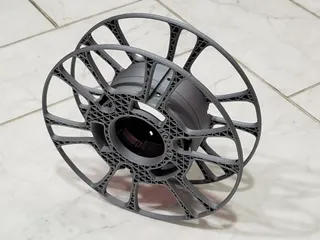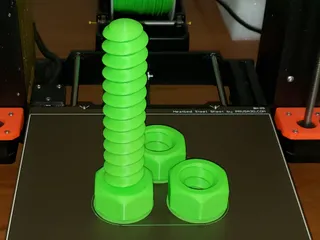Perfect-fit plate stand / bowl stand
Description
PDFA client needed a folding stand for a custom wooden bowl. After searching Thingiverse for "plate stand" and "bowl stand" and finding nothing, I designed a custom stand that would fit any bowl perfectly, and include areas for engraving and embossing text. The client is OK with making this publicly available.
The STL file included is for a generic plate. If you want a customized stand for a bowl or different plate, you must adjust the parameters in the OpenSCAD file, which are pretty straightforward. The model for a bowl or plate requires 6 different measurements.
- overall height (
bowl_ht) - largest diameter (
max_dia) - diameter of top rim (
rim_dia) - diameter of base (
base_dia) - height of rim above largest diameter (
rim_ht) - depth of recess in base (
base_recess)
Here are how those parameters work in the OpenSCAD script:
|<------ rim_dia ------>|
_________________________ ______
/ ^ \ rim_ht
/ | \ _____
\ bowl_ht /
\ | /
\ _______|______ /_______
\__/ v \__/ __ base_recess
|<----- base_dia ---->|
|<-------- max_dia -------->|The script creates a virtual bowl with a rounded shape that connects these measurements, and constructs the stand around that virtual bowl.
There are several more advanced parameters, for up to four text labels (one on the inside and outside surface of each leg), tilt angle, maximum opening angle, and so on.
(13 March 2021 - updated .scad with improved foot cutout for cylindrical bowls; the original STL is still fine though.)
Print settings
Printer: Prusa i3 MK3S
Supports: No
Resolution: 0.30 mm adaptive
Infill: 15% gyroid
Filament: Generic PLA Bronze
Notes:
If you have PrusaSlicer, I recommend 0.30 mm draft profile with automatic adaptive layer height using a quality/speed setting of 0.5 (which makes layers thinner as needed). This can save about an hour of printing time. It comes out looking good, although it doesn't really have to look good because the stand is mostly hidden by the bowl or plate.
Post-printing
After printing, you need a short length of 1.75mm filament to serve as a hinge pin to tie the two legs together.
- Cut a piece of filament a couple centimeters longer than the length of the hinge.
- On a stove burner, or a hot frying pan, push one end of the filament onto the hot surface to expand the end a bit, so it cannot slip through the hinge.
- Thread the filament through the hinge.
- With the filament all the way in, trim it so 3-5 mm of filament protrudes out the other end of the hinge.
- Heat up a flattish metal object (dinner knife, end of a teaspoon) enough to melt the filament and press it onto the protruding end of the hinge pin to expand it, trapping it in the hinge.
- Alternately, with the filament in place, you can put a drop of superglue in the hinge to bind the filament to the hinge. The hinge will still rotate with superglue on one or both ends.
How I designed this
Designed completely in OpenSCAD, with a pencil and paper to work out a number of trigonometry problems associated with this model.
Change log
- March 2021 - improved foot cutout for cylindrical bowls
- October 2023:
- added support for faceted bowls
- fixed bearing wall thickness error to make hinge slightly bigger
- setting hook_ht=0 now allows for a stand that hooks into an edge at the middle of the bowl; just make that edge the rim and and bowl_ht be the height of the rim
- beveled some corners near the hinge to prevent build plate separation
- loosened hinge part clearances
- October 2024: fixed top hinge closing at large table clearance values
Category: Decor
Tags
Model origin
The author marked this model as their own original creation. Imported from Thingiverse.




